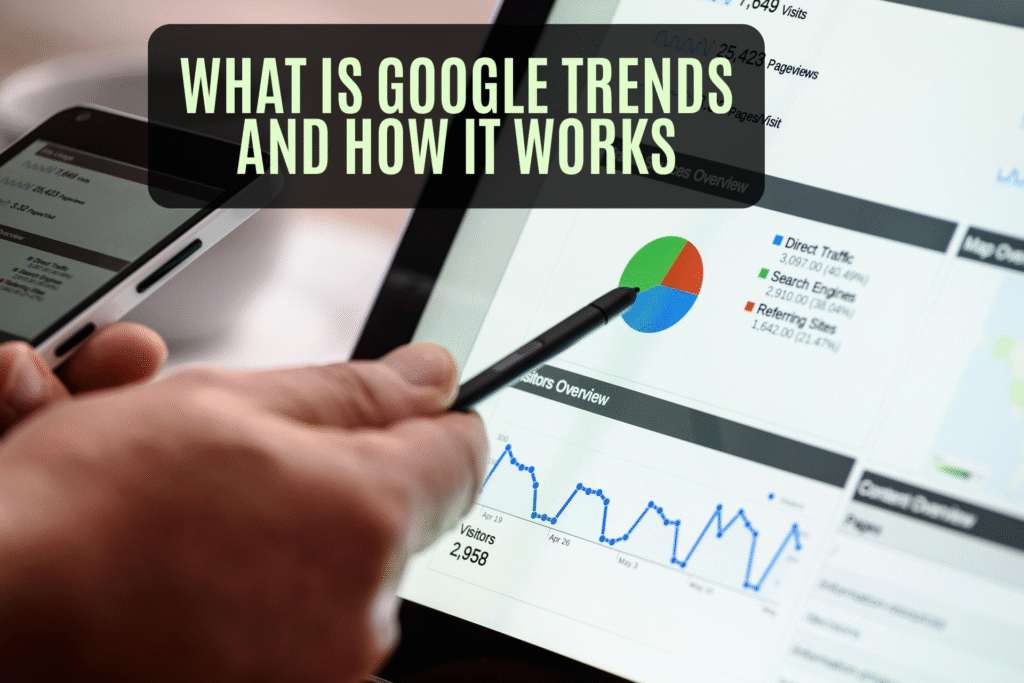Welcome to another of our entrepreneurial blogs. If you’re searching for inspiration, strategies, or simply the best small business ideas, you’re in the right place. Staying ahead of consumer behavior is a competitive necessity. With audiences demanding instant relevance and personalization, marketers must rely on data-driven insights to understand what people truly care about. One of the most powerful yet underrated tools that provides this kind of insight is Google Trends.
Here are some of our popular posts: Top 10 best website builders, Best super foods for a healthy lifestyle, the unlimited list of free productivity apps, Best freelance site to find remote jobs, top 10 productivity hacks for entrepreneurs , 10 best side hustles to make extra money online, best online courses for learning digital skills, top 10 best free coding website
Suppose you learn how to use Google Trends effectively for marketing purposes. In that case, you can uncover real-time trends, understand audience behavior, and craft marketing strategies that are both timely and effective.
This comprehensive guide explores how to use Google Trends for marketing. What Google Trends is, why it’s essential for modern marketing, how to use it strategically, and practical ways to apply it to content creation, SEO, and advertising campaigns.
Whether you are a seasoned marketer, a startup founder, or an entrepreneur, mastering Google Trends will give you a competitive edge in 2025.
What Is Google Trends and How It Works

Google Trends is a free analytics tool from Google that tracks the popularity of specific search terms across time, locations, and platforms. It gathers data from billions of daily searches to reveal how people’s interests change and evolve.
Instead of showing absolute numbers, it displays relative interest on a scale of 0 to 100, helping marketers see when a topic gains or loses traction. You can also compare multiple keywords, explore related topics, and discover which regions or countries are most engaged with a specific subject.
For example, if you search for “digital marketing in Canada,” Google Trends can show when interest peaks, which states are most active, and what related searches people are making. This makes it an invaluable tool for marketers who want to stay in sync with audience behavior.
Key Google Trends Features in 2025

#1. Search Volume Index Showing Popularity Over Time
This feature allows marketers to see how interest in a specific keyword or topic changes over a chosen period. Instead of showing the exact number of searches, Google Trends provides a relative score from 0 to 100. A score of 100 represents the peak popularity of a term, while 0 means there was not enough data during that time frame. This helps businesses track whether a topic is growing, stable, or declining. For example, if searches for “AI marketing tools” have risen steadily in the past six months, it signals a growing opportunity to create content or products around that area.
#2. Regional Interest Breakdown to Identify Top-Performing Locations
Google Trends shows where a particular search term is most popular, allowing you to see the geographic distribution of interest. This data is crucial for localized marketing.
By understanding which countries, states, or cities are most engaged with a specific keyword, marketers can tailor their campaigns to those areas. For instance, if “digital marketing courses” trend higher in Silicon Valley than on Wall Street, a business offering such courses can focus its advertising and promotions in Lagos for better results.
#3. Related Queries and Topics for Keyword Expansion
When you enter a search term, Google Trends automatically generates a list of related queries and topics. These are terms that people often search for alongside or instead of your chosen keyword. They reveal emerging interests, subtopics, and trending phrases.
For marketers, this is a valuable resource for discovering new content ideas, expanding keyword lists, and staying relevant. For example, someone searching “e-commerce business” might also look for “dropshipping in America” or “online store platforms,” giving you insights into potential areas to explore.
#4. Real-Time Trend Tracking from the Last Hour to the Last Five Years
In 2025, Google Trends offers a powerful real-time data feature that lets users track search patterns over different time periods—from the past hour to the last five years.
This flexibility is essential for understanding both short-term viral trends and long-term market shifts. For example, during a live event or product launch, marketers can monitor how quickly search interest is rising. On the other hand, long-term data helps identify consistent demand cycles, such as yearly interest in “Black Friday deals” or “holiday travel.”
#5. Industry-Based Filtering to Narrow Down Data to Relevant Niches
Google Trends allows users to filter search data by industry or category, such as health, finance, technology, or entertainment. This ensures that the insights you gather are specific to your market and not influenced by unrelated searches.
For example, a healthcare company searching for “wellness” trends can limit results to the health category to get more accurate insights about patient interests rather than general lifestyle trends. This level of filtering helps marketers craft campaigns that resonate directly with their target audience.
The Role of Marketing Strategy in 2025

Before you can effectively use Google Trends for marketing, you need a clear and well-defined strategy. A marketing strategy outlines your long-term approach to attracting, engaging, and converting your audience. It defines your business goals, communication channels, and key messaging.
In 2025, with the rise of AI-driven personalization, stricter data privacy regulations, and heightened market competition, having a solid marketing strategy has become more essential than ever. A well-structured strategy helps you set clear objectives that align with your overall business goals. It allows you to allocate resources wisely, ensuring that every effort contributes to measurable growth rather than wasted spend.
A strong strategy also maintains consistent brand messaging across all digital platforms, helping you build trust and recognition among your audience. It enables you to react quickly to shifts in consumer behavior and market conditions, keeping your campaigns flexible and relevant. Most importantly, it provides a framework for measuring performance and optimizing results using accurate data and analytics.
When you use Google Trends for marketing within this structured approach, it acts as a real-time compass guiding your decisions, refining your content direction, and ensuring your marketing efforts remain aligned with the ever-changing interests and needs of your audience.
10 Reasons to Use Google Trends for Marketing in 2025

#1. Spot Emerging Trends Early: Google Trends helps you identify new topics gaining traction before they go mainstream. By acting early, you can position your brand as an authority on trending subjects and capture audience attention before competitors do.
#2. Understand Seasonal Demand: Every market has its peak periods. By using Google Trends, you can discover when people are most likely to search for certain products or services. This allows you to plan campaigns, discounts, and content around high-demand seasons.
#3. Compare Brand vs Competitor Performance: Google Trends lets you compare multiple keywords or brand names to see which one attracts more searches. This feature is great for understanding brand visibility, audience interest, and competitive positioning.
#4. Localize Your Campaigns: Consumer interest often varies by region. You can use Google Trends to find out where your topic is most popular and tailor your campaigns accordingly. For example, if “online shopping” trends more in Lagos than Abuja, you can allocate more budget and content focus to Lagos.
#5. Validate Content Ideas: Before writing a blog post, recording a video, or launching a campaign, use Google Trends to see if the topic is gaining or losing popularity. This ensures your content stays relevant and engaging.
#6. Optimize SEO and Keyword Research: Google Trends helps you identify the best keywords to use in your website content, ads, and social media posts. You can focus on rising keywords rather than those that are declining, ensuring your SEO strategy remains fresh and competitive.
#7. Monitor Consumer Sentiment: By analyzing search trends around specific topics, you can gauge how consumers feel about certain issues or products. This helps adjust your messaging tone and marketing approach accordingly.
#8. Guide Product Development: Businesses can use Google Trends to identify what features or products people are searching for most. For example, a tech company could discover a growing interest in “AI-powered apps” and align its next product launch with that trend.
#9. Refine Audience Insights: Google Trends provides demographic and regional information about who is searching for your keywords. This can help refine audience personas and improve targeting accuracy for ads and content.
#10. React Quickly to Real-Time Events: In a world where trends shift overnight, reacting fast is key. Google Trends helps you spot surging interest in breaking news or viral topics, allowing you to join relevant conversations and boost visibility instantly.
Step-by-Step Guide: How to Use Google Trends for Marketing in 2025

#1: Define Your Goals: Before diving into data, decide what you want to achieve. Are you trying to boost SEO, find content ideas, analyze competitors, or plan ad campaigns? A clear goal helps you focus your search.
#2: Search for Relevant Keywords: Type in keywords related to your niche and review their popularity trends. Pay attention to rising or breakout terms—these indicate growing interest that you can capitalize on.
#3: Analyze Interest Over Time: Use the interest-over-time chart to see how search volume changes. If a keyword shows steady growth, it’s a sign of consistent interest. Declining terms may not be worth investing in.
#4: Compare Multiple Keywords: Use the comparison feature to evaluate up to five keywords at once. This helps you determine which term has the highest engagement and long-term potential.
#5: Explore Regional Interest: Click the map view to see where searches are most common. Focus your marketing efforts on those high-performing regions for better ROI.
#6: Review Related Queries and Topics: Google Trends automatically suggests related queries and topics. These can inspire new blog posts, video ideas, and ad campaigns based on what users are already searching for.
#7: Use Filters for Precision: Filter results by category, location, and time range to make your analysis more specific. You can even view trends for different platforms, such as YouTube or Google Shopping.
#8: Integrate Google Trends with Other Tools: Combine your insights from Google Trends with data from Google Analytics, Google Ads, and social media platforms. This gives you a more complete picture of consumer intent.
#9: Test, Launch, and Monitor: After applying Google Trends insights, track your performance. See if the campaign aligns with predicted patterns. Refine based on real-time results.
#10: Make Trend Tracking a Routine: Trends shift constantly. Make it a habit to check Google Trends weekly. It keeps your marketing strategy adaptive and future-proof.
Practical Examples of Using Google Trends for Marketing

#1: Content Marketing
A health blogger wants to attract more readers. By using Google Trends, they discover that “intermittent fasting in Nigeria” is trending. They write an in-depth article on the topic, optimized for SEO, and see a 40 percent traffic increase within a month.
#2: Product Launch
A tech company preparing to launch a smart home device uses Google Trends to identify that searches for “AI home automation” are rising in New York and Texas. They adjust their ad targeting and messaging to focus on these cities, boosting sales by 25 percent.
#3: Local Marketing
A restaurant chain uses Google Trends to discover that “best breakfast spots” is trending in Abuja. They launch a breakfast campaign with local ads and social media posts, resulting in higher foot traffic and online engagement.
These real-world applications prove that learning how to use Google Trends for marketing can directly impact your business outcomes.
Advanced Ways to Use Google Trends for Marketing

#1. Predict Future Demand
By analyzing long-term data, you can forecast upcoming trends and prepare in advance. For example, if “electric vehicles” have shown steady growth for three years, it indicates a long-term opportunity.
#2. Segment by Platform
Google Trends allows filtering data by platform, such as YouTube. Video marketers can use this to find trending topics specifically for video content.
#3. Leverage Breakout Queries
Breakout queries show a surge of more than 5000 percent in search interest. These are goldmines for viral marketing. Acting fast on them can catapult your brand visibility overnight.
#4. Create Trend-Based Ads
Align your paid campaigns with rising keywords. Launching ads around trending topics boosts engagement rates and lowers cost per click.
#5. Track Public Interest in Your Brand
Search your brand name in Google Trends and compare it to competitors. If your trend line grows steadily, it shows increasing brand recognition. If not, you can adjust your promotional strategy.
Conclusion: Use Google Trends for Marketing
The most successful brands are those that understand how to use Google Trends for marketing, not just as a keyword tool, but as a powerful predictive insight engine. It serves as a bridge between real-time audience behavior and strategic decision-making, allowing businesses to make informed choices backed by data rather than assumptions.
Here are some of our popular posts: Top 10 best website builders, Best super foods for a healthy lifestyle, the unlimited list of free productivity apps, Best freelance site to find remote jobs, top 10 productivity hacks for entrepreneurs , 10 best side hustles to make extra money online, best online courses for learning digital skills, top 10 best free coding website
By consistently using Google Trends, marketers can anticipate shifts in consumer interest, identify new opportunities before they become mainstream, and craft marketing campaigns that truly resonate with their audience. It provides the clarity needed to align your efforts with what people are actively searching for, helping you stay one step ahead of competitors.
To get the most value from Google Trends, it is important to use it strategically and consistently. Checking it weekly helps you identify emerging opportunities early and adapt your campaigns in real time. Combining it with tools like Google Analytics gives you deeper insights into how people interact with your content and where improvements can be made.
You can use it to guide your SEO strategy, refine your content creation process, and even inspire new product ideas based on search patterns. Paying attention to breakout terms is equally essential because they represent fast-rising topics that could go viral if leveraged quickly. However, always remember to interpret the data within the context of your industry to avoid misjudging trends or chasing irrelevant spikes in interest.


